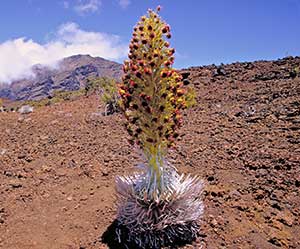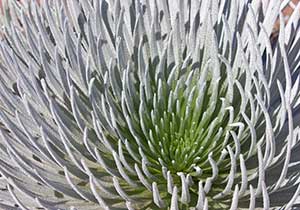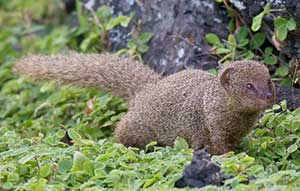 |
| Haleakala Silversword. |
 |
 |
| Indian Mongoose, Maui, Hawaii. |
Island Flora & Fauna
By adapting to a variety of food sources and habitats through the process of adaptive radiation, a single finch-like ancestor from the Americas gave rise to an estimated 52 species of Hawaiian honeycreepers. The slightly curved bill of the 'ākohekohe is ideal for feeding on the nectar of native flowers. Strategies for feeding on insects resulted in other bill shapes: the 'akialoa (probably extinct) foraged among leaves and branches; the 'alauaio feeds on insect larvae and nectar of 'ōhi'a and lobelia flowers; and the Maui parrotbill crushes twigs to find prey.Endemic species evolved in the Hawaiian Islands from ancestral colonizers and are unique to a specific area. Haleakala 'āhinahina is a silversword endemic to the upper slopes of Haleakala. This 'āhinahina grows as a compact rosette of narrow silvery leaves for up to 50 years before finally flowering. After flowering once in its lifetime, the plant dies. The endemic insects that pollinate the Haleakala 'āhinahina are essential to the long-term survival of these fragile plants and are dependent on them for nourishment.
Foreign species of plants and animals introduced purposely or accidentally by humans are known as aliens. Alien species have reduced populations of native Hawaiian species and in some cases threaten their survival. Aggressive alien plants, such as kahili ginger, can spread into remote forests, displacing native vegetation. Goats eliminate vegetation, resulting in severe erosion. Mongooses originally brought to the Hawaiian Islands to control rats in sugar cane fields, prey on the eggs and young of ground-nesting birds.
The State of Hawaii includes only two-tenths of a percent of the total U.S. land area, yet on-third of the plants and birds listed or considered for listing on the Federal Endangered Species List are Hawaiian. The impact of human activities on native species and ecosystems cannot be completely undone, but active management is limiting and even reversing some of the damage. Today's natural are managers build fences, control alien species, restore native vegetation, and work to increase our knowledge of Hawaiian ecosystems.